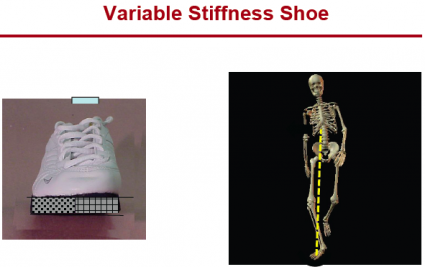Future Now
The IFTF Blog
Resilient Joints, Streets, Societies (thoughts on Laura Carstensen)
Resilience: bouncing back, recovering, improving. But at what scale? A step? A body? A stairway? A sidewalk? A neighborhood, or city? A whole culture of expectations and assumptions?
All of them. That's one of the central points I got out of Laura Carstensen's talk last Thursday. But why am I talking about steps and sidewalks? Dr. Carstensen (Director of the Stanford Center on Longevity) pointed to her colleague's work in Kinesthesiology and Biomechanical Engineering as an example of the kind of re-engineering of pervasive experiences for the transformation of aging. Thomas Andriacchi specializes in human locomotion, and he invented a shoe that delays, ameliorates, and treats osteoarthritis. The shoes, indistinguishable from normal shoes (especially in the Nike-sponsored prototype) shift weight away from inflamed joints, retrain the gait, extending and restoring full mobility.
By 2020, the number of people with osteoarthritis will rise to 59 million and it’s probably the major cause of people over 50 losing the ability to function in a normal array of activities,” Andriacchi explains.
 Andriacchi_shoe-gait: Shoe modifies gait to delay, ameliorate and treat osteoarthritis.
Andriacchi_shoe-gait: Shoe modifies gait to delay, ameliorate and treat osteoarthritis.
image from Andriacchi et al 2009
With a carefully designed shoe, wearers can make their joints more resilient, staving off and recovering from pain for a more active lifestyle… more activity being linked also with greater mental and emotional resilience, I might add.
But the room was also full of planners. Shuffling around the house is still just that: equally important are policies governing the presence, maintenance and accessibility of sidewalks. Even policies governing the integration of spaces for older people with other demographics and services, allowing these communities and usages to support each other, several participants propounded. Diversity of community design, mixed usage not only increases accessibility and vibrancy, but resilience when any given segment is in trouble.
Much more broadly than that, Carstensen argued, resilience in the face of aging, and the technologies to support that, need to become a cultural norm. Greater cognitive reserve, aging well, etc need to be transmuted from the privileges of the very well educated and the relatively wealthy into a basic, taken-for-granted expectation that "remakes" the world in which we live. It needs to incorporate redundancies, peruse diverse avenues, and (I would add) fail gracefully. She drew the parallel to childhood mortality in the 20th Century: sure, the children of the poor still die at a higher rate than others, but we no longer see this as an wholly intractable fact. We're already in a demographic, socio-cultural and technical spot where the bespoke "tsunami of aging" is going to hit us, and hit us nontrivially hard in tandem with all the other challenges we face. She insists it will be possible to recover from that with the tools to bolster life expectancy with greater equity and grace.
How?
Her narrative is rooted in Science and Technology… the power of technical advances to become invisible while profoundly changing our lives and the risks we face. But the methods she recounted in her conclusion and in Q&A spanned response strategies. Policy was inextricable for some fundamental changes and some nagging details. Markets are the jump-cable for her mission: the Center on Longevity is set up to team up scientists with business students and entrepreneurs to incubate and prototype rapidly, just to get things out there.
But these aren't sufficient, they aren't where she concluded. Markets are rapid, but only if you accept a period of new and stark inequalities. Policy is extraordinarily effective when it is, and frustratingly pointless when it isn't (the grumbling consensus in the room, and in fact in a lot of rooms I've been in recently, is that right now good policy is a pipe dream). She ended with the commons: with a call for a common-good social movement of baby boomers and all aging people (yeah, raise your hand if you think you're not aging) engaging on grassroots, political, and even commercial levels. Her call to create this vision is one of biocitizenship, with the shared attribute being our own senescing bodies.
<<Vivian et al.: please don't cross-post this to HH per your threat. I wanna clean some of these up and post them c. conference time>>



